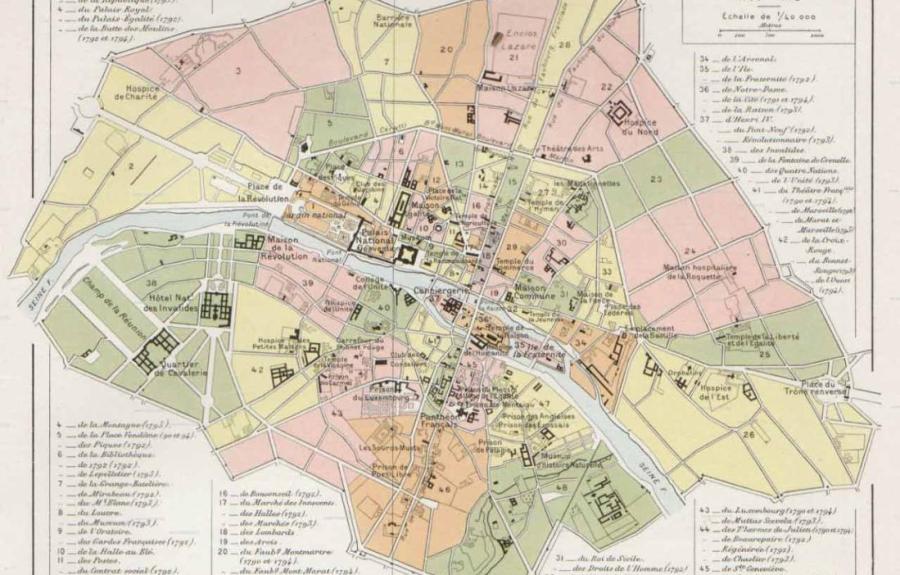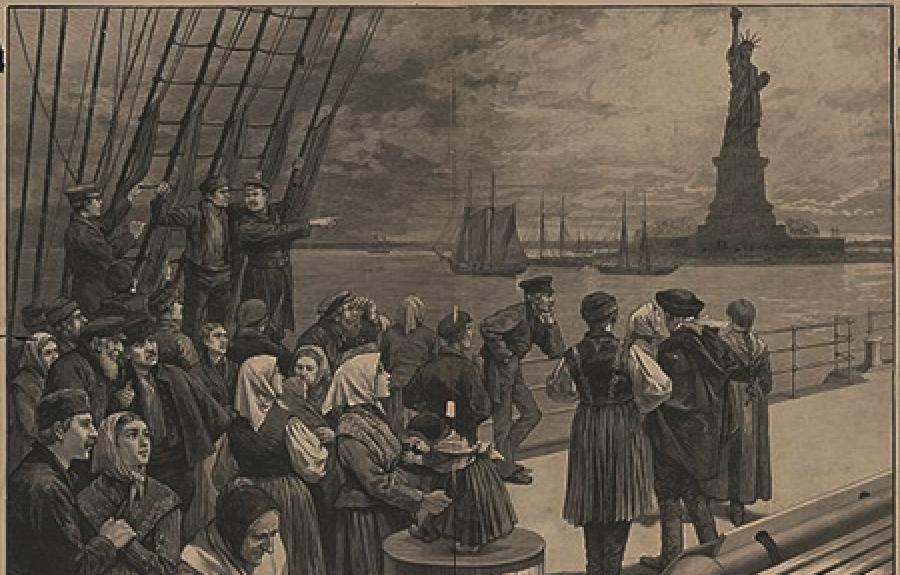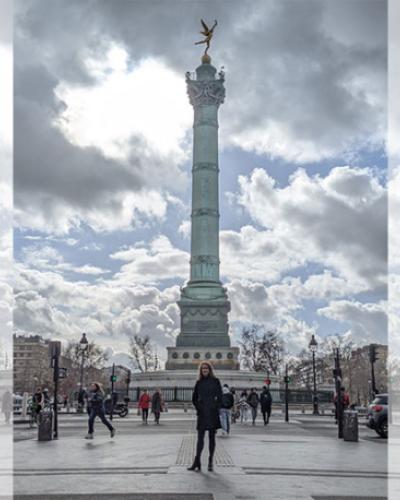Samantha Wesner's Ph.D. dissertation titled "Galvanizing the Citizen: Electricity and Revolutionary Energy in the Age of Democratic Revolutions" is an interdisciplinary study of the intertwining of electricity and revolution—a complicated relationship that goes beyond the eighteenth century and speaks to connections between science, technology and political power.
A. As an undergrad, I took a research seminar on the French Revolution. I was mystified by all the references to particular dates—"August 10th," "July 14th," and even "22 prairial"—I was motivated to master the French Revolutionary timeline. The more I learned, the more I wanted to understand: What was so important about this moment in history? What was novel about it?
Q. What did you learn and what happened from there?
A. According to the traditional narrative, "modernity" began with the French Revolution. In some interpretations, it began on July 14, 1789, when a mob seized a fortress and political prison, the Bastille. Though only seven prisoners were found within, the defeat of the prison was a potent symbol of the People's power at a moment of constitutional crisis. 1789 and the revolutionary decade that followed have been interpreted as a crucial break with the past practically since it occurred. Feudalism, the story goes, with its reign of kings, queens, nobles and clergymen, was being replaced with a new regime, one in which the language of individual rights and the power of capital shaped the political landscape.
Sitting in Uris Library one day, reading Mona Ozouf's "Festivals and the French Revolution," I came upon this quote about the festival held on the Bastille's first anniversary: "The festival celebrated the passage from the private to the public, extending to all the feeling of each individual 'by a kind of electrical charge.'"
I was surprised. I thought to myself, "electricity? in 1790?" So, I decided to investigate. Looking up the citation, I found that Cornell had a copy of the original pamphlet Ozouf was quoting in Cornell's Rare and Manuscript Collections.
Sure enough, in a pamphlet written by a somewhat obscure architect, Bernard Poyet, I found this intriguing electrical vocabulary. In the festival, Poyet envisioned, "the sentiment of each becomes the sentiment of all by a kind of electrification."
From this one quotation, I saw that the idea of electricity was central to how this architect thought about what would happen at this all-important festival, consecrating the taking of the Bastille and the new revolutionary regime.
One of the joys of being a grad student is taking a deep dive into something interesting like this. I ended up publishing an article focusing on this quotation in the British Journal for the History of Science last year. The intersection I had found between electricity and revolutionary energy suggested several research questions that I wanted to answer: "How did revolutionary language make use of electricity? Was it a metaphor or something more than a metaphor, according to the science of the time?"
Q.How did your dissertation project evolve?
A.The dissertation project I envisioned required a background in science and technology studies. I took a graduate research seminar called A New Atlantis: Early Modern Literature, Science, and Empire co-taught by Profs. Suman Seth (Science and Technology Studies) and Jenny Mann (English). This interdisciplinary class brought science and technology studies into conversation with literary studies. The connections drawn in this class inspired me to take an interdisciplinary approach to the curious electrical vocabulary I had found in the archives. Convinced that the history of electricity at the turn of the nineteenth century could illuminate new aspects of the democratic revolutions happening at the same time, I set out to write an account of how a political language of electricity was invented. I wanted to see what impact electricity may have had on concepts of revolutionary "energy."
Q. Let's talk about the animated map you made last summer. This web page on carto.com depicts that map. What is the map showing the viewer? What period does your map represent?
A. This map depicts each instance of electrical language found in the parliamentary archives during the revolutionary decade: 1789 to 1799. Each animated spot shows where and when someone used an electrical term—electricité, électrique, électrisation, etc. They were used in speeches, pamphlets, and festival minutes. As the map shows, electrical language is concentrated around the time known as the terror, when the Jacobins were in power.
Q. How might this be a valuable tool to other students of history?
A. Carto is a powerful mapping software available at Cornell, and it is an excellent resource for students researching history as it provides a different perspective on data. Animating data and viewing it in the aggregate can illuminate patterns that we are unable to see otherwise.
For example, the map allows us to see a movement of electrical language from northeast France to southwest France from 1792-3. This would have been impossible to detect without visualizing the data. You can also see a few instances of electrical language popping up in Haiti, which was then the French colony of Saint Domingue. The map also shows us how electrical language fell rapidly out of the lexicon in the winter of 1793-94. This suggests something distinctive about the fall of 1793, which historians have missed because of the usual periodization of the terror.
Q.How did you compile the information to include on the map?
A. For my dissertation, I went through the parliamentary archives and recorded instances of electrical language. I used both the digital archives available through a collaboration between Stanford and the Bibliothèque nationale de France, as well as the physical archives located in Paris. As a Digital Humanities Fellow for the summer of 2021, I decided to map and animate the whole body of data. Using OpenRefine (a free software program that sorts data), I went back through my spreadsheet, geotagging each entry and adding dates.
Q. Electricity: this is the word you point to in your paper as having meaning in the scientific community that politicians applied to the French Revolution. Can you share one example of a scientific interpretation of electricity that led to a political interpretation?
A. Yes, one example is a demonstration frequently performed by so-called "electricians" in the eighteenth century. This demonstration featured a Leyden Jar, a literal jar that was charged with electricity so that if you touched its top and bottom at once, the circuit would run through your body, delivering a powerful shock so powerful it killed some experimenters in the early days.
The demonstration happened as follows: a group of people stood in a circle holding hands, forming a human chain. The first person in the chain touched the top of the Leyden Jar. The second (the last person in the chain) touched the bottom, a massive shock of electricity passed through the whole chain, every person feeling it at practically the same time. The French natural philosopher Jean-Antoine Nollet was known for this demonstration, famously shocking a human chain of 180 soldiers in front of King Louis XV. Legend had it he had shocked 600 people at once.
When the architect Poyet imagined a "kind of electrification" operating at the festival in commemoration of Bastille Day, he was likely thinking of this kind of demonstration. The idea of the "sentiment of each" becoming the "sentiment of all" recalls the simultaneous shock felt by all who partook in the human chain at the center of the Leyden Jar demonstration.
Q.Thinking about your research, how might your rich synthesis of the intersection of science and political history help analyze some of humanity's problems going forward? Do you think history can be used more proactively to solve humanity's problems?
A.This is a very important question for historians to reflect on. This intersection is an important one for some of the issues we face today, particularly those related to technology and climate change. The problems we face have deep histories. To really understand these problems and to develop informed solutions, we need an understanding of the history behind them.
Q.What has life been like in Paris for a graduate student?
A.In the fall of 2020, when I arrived, France went under strict lockdown after a summer of reprieve. Under a nation-wide policy called "confinement" we were confined to a one-kilometer radius around our apartments, allowed outside for an hour of exercise per day. Masks were required indoors as well as on the street. This strict confinement became a six-pm curfew that dragged on through the winter, accompanied by daily pandemonium at the corner grocery around 5:45.
When vaccines became available, we lined up outside the soccer stadium to get our shots. In late summer, Macron debuted the controversial pass sanitaire, requiring vaccination proof for everything from entering a café to taking the TGV, France's high-speed rail. The indoor mask requirement was never lifted. Still, France's omicron cases soared in January, reaching a record of 500,000 new cases in one day.
Between lockdowns and restrictions, I've taken graduate seminars at the École des Hautes Études en Sciences Sociales, attended and hosted social events organized through the H-France listserv, and enjoyed many a croissant. Like most grad students, I've relied heavily on digitized resources since March 2020. Cornell library's "scan and deliver" has been a lifesaver. The Digital Humanities Fellowship was also fully remote, and an excellent way to stay connected to Cornell from abroad. And thanks to remote options, I could still attend the history department's Graduate Colloquium and learn about my colleagues' work. All told, these have not been easy years to be anywhere, but to quote a friend, if you must lockdown, you might as well lockdown in Paris.
To read more about Samantha's research, check out her Cornell webpage.









